How to decipher Italy's mind-boggling pasta menus

In case you hadn’t noticed, Italians take pasta very seriously. There are dozens of varieties, and menus can be hard to decipher to visitors and newcomers.
Pasta is an art form; not only does each region have its local specialities, but there are rules as to which sauce goes best with which pasta.
To start with, Italians would never pair chicken or meatballs with any type of pasta - and don't even think about topping a seafood pasta dish with cheese.
READ ALSO: 10 surprising pasta facts in honour of Italy's favourite food
Menus can become confusing. There are so many different kinds of pasta out there that sometimes you don't realise it's pasta, let alone what shape.
Waiters have been known to draw pasta shapes in order to help diners understand what they're ordering, while many foreigners in Italy have sat through lectures from Italian housemates on why you should never, ever order spaghetti bolognese.
So to help you blend in and impress your Italian friends, here is our guide to the country's favourite food.
Capelli d’angelo
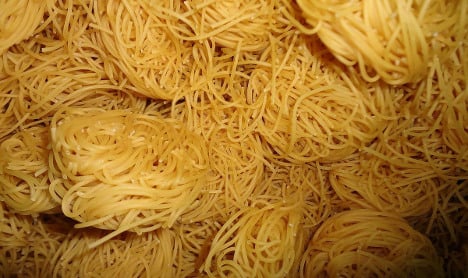
Photo: David Adam Kess/Wikimedia Commons
Literally translating as 'angel hair', this pasta is very thin and light, meaning it cooks very quickly. It is sold either in strands or 'nests' and should be eaten with light sauces or can be used in soups.
Capelli d'angelo is in the same pasta family as fidelini (slightly thicker), spaghetti (even thicker) and vermicelli (thickest), all of which work best with lighter sauces, often seafood-based, and can be used in soups.
Bucatini
 stu_spivack Flickr.jpg)
Photo: stu_spivack/Flickr
Bucatini is another long, skinny pasta, but with one crucial difference - it is hollow. The tube shape allows sauce to flow through it, making it a great partner with thicker, meatier sauces than the thinner strands can handle. Bucatini is particular popular with amatriciana, a Lazio sauce made from guanciale (pig's cheek).
Mafalde
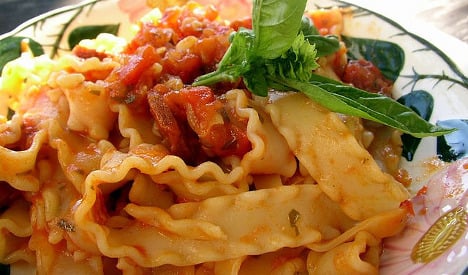
Photo: Yaksar/Wikimedia Commons
Named after Princess Mafalda of Savoy, and sometimes also called reginette (little queens), these are flat, wide ribbons with wavy edges, allowing them to pick up chunks of sauce.
They are used in a similar way to other ribbon pastas: linguine ('little tongues' with an eliptical cross-section), tagliatelle (ribbons), fettuccine (wider ribbons), pappardelle (widest), all of which go well with meaty or thicker sauces. For example, 'bolognese' sauce or ragu is usually eaten with tagliatelle in Italy - never spaghetti.
READ ALSO:
- OPINION: In defence of spaghetti bolognese
- The original recipe for authentic bolognese sauce
- Eat away: Italian study shows pasta doesn't make you fat
Mezze maniche
The name translates as 'half sleeves' and they are also known as maniche di frate (friar's sleeves), inspired by the shorter-sleeved garments worn by religious men in the summer, and are short tube shapes.
Tubes are one of the most popular kinds of pasta and there are many varieties - from thin, ridged penne to large rigatoni. They are designed to hold thick sauces in the ridges and tubes.
Strozzapreti
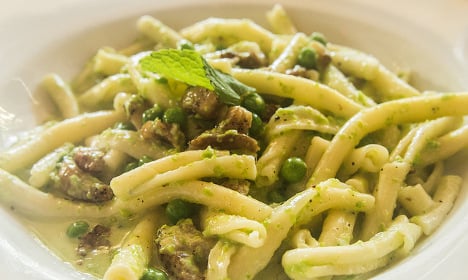
Photo: Edsel Little/Flickr
These are short twists of pasta, usually served with light, smooth sauces and pesto in particular, and a local speciality in Emilia-Romagna.
Their name literally means 'priest stranglers' and is thought to come from the legend that greedy priests would eat the pasta so quickly that they would choke - it could also be because their shape resembles a priest's collar. Pici are a similar kind of pasta made in neighbouring Tuscany.
Trofie
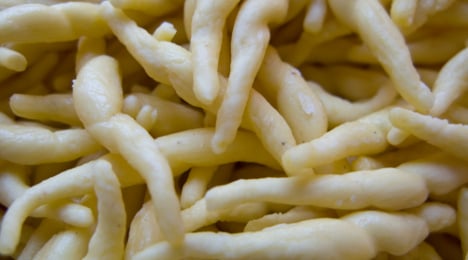
Photo: Tom/Wikimedia Commons
Usually eaten with pesto, trofie are smaller and denser than strozzapreti but made in a similar way by rolling the dough. Their name probably comes from the Ligurian word 'strufuggiâ' (to rub) as a reference to this method.
Casarecce

Photo: zkruger/DepositPhotos
Casarecce come from Sicily, and they are a narrow, twisted shape - the name means 'homemade' so the shapes are rarely uniform. Sturdier than strozzapreti or trofie they can handle thicker, creamy or chunky sauces.
Fazzoletti

Photo: Meg Lauber
Fazzoletti get their name from the Italian word for handkerchiefs, and they are flat and square-shaped, often made with herbs rolled into the dough. Because of this, they are usually served with simple dishes to let the flavour come through, such as butter, Parmesan and just a drizzle of olive oil.
Orecchiette
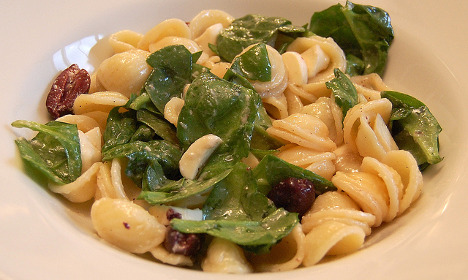
Photo: Rooey202/Flickr
Their name literally means 'little ears' due to the small bowl-shape which is used often with heavy, vegetable-based sauces, especially with broccoli.
There are plenty of other pasta shapes which are good at holding chunky sauces, including farfalle (butterflies), cavatappi (corkscrews), radiatori (little radiators) and many spiral varieties including classic fusilli.
Gigli
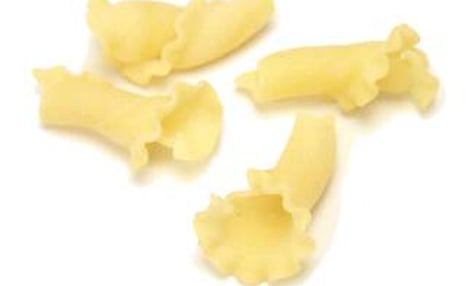
Photo: Sreebot/Wikimedia Commons
Gigli are from Florence, and the name translates as 'lily' - the city's emblem, which the shapes resemble. They are cone-shaped and can be used with heavier sauces.
Conchiglie/oni

Photo: freestock.ca/Wikimedia Commons
Conchiglie is Italian for 'shells', and the seashell shape allows them to pick up sauce, just like other shaped pasta. However, conchiglioni (literally 'big shells') are usually filled - popular fillings include ricotta and spinach, pumpkin, or beef and bechamel sauce.
Other varieties of filled pasta are ravioli and tortellini, which are small and usually served with a light sauce, and cannelloni and lasagne, which pair well with heavy ragu or creamy sauces.
Comments (1)
See Also
Pasta is an art form; not only does each region have its local specialities, but there are rules as to which sauce goes best with which pasta.
To start with, Italians would never pair chicken or meatballs with any type of pasta - and don't even think about topping a seafood pasta dish with cheese.
READ ALSO: 10 surprising pasta facts in honour of Italy's favourite food
Menus can become confusing. There are so many different kinds of pasta out there that sometimes you don't realise it's pasta, let alone what shape.
Waiters have been known to draw pasta shapes in order to help diners understand what they're ordering, while many foreigners in Italy have sat through lectures from Italian housemates on why you should never, ever order spaghetti bolognese.
So to help you blend in and impress your Italian friends, here is our guide to the country's favourite food.
Capelli d’angelo
Photo: David Adam Kess/Wikimedia Commons
Literally translating as 'angel hair', this pasta is very thin and light, meaning it cooks very quickly. It is sold either in strands or 'nests' and should be eaten with light sauces or can be used in soups.
Capelli d'angelo is in the same pasta family as fidelini (slightly thicker), spaghetti (even thicker) and vermicelli (thickest), all of which work best with lighter sauces, often seafood-based, and can be used in soups.
Bucatini
 stu_spivack Flickr.jpg)
Photo: stu_spivack/Flickr
Bucatini is another long, skinny pasta, but with one crucial difference - it is hollow. The tube shape allows sauce to flow through it, making it a great partner with thicker, meatier sauces than the thinner strands can handle. Bucatini is particular popular with amatriciana, a Lazio sauce made from guanciale (pig's cheek).
Mafalde

Photo: Yaksar/Wikimedia Commons
Named after Princess Mafalda of Savoy, and sometimes also called reginette (little queens), these are flat, wide ribbons with wavy edges, allowing them to pick up chunks of sauce.
They are used in a similar way to other ribbon pastas: linguine ('little tongues' with an eliptical cross-section), tagliatelle (ribbons), fettuccine (wider ribbons), pappardelle (widest), all of which go well with meaty or thicker sauces. For example, 'bolognese' sauce or ragu is usually eaten with tagliatelle in Italy - never spaghetti.
READ ALSO:
- OPINION: In defence of spaghetti bolognese
- The original recipe for authentic bolognese sauce
- Eat away: Italian study shows pasta doesn't make you fat
Mezze maniche
The name translates as 'half sleeves' and they are also known as maniche di frate (friar's sleeves), inspired by the shorter-sleeved garments worn by religious men in the summer, and are short tube shapes.
Tubes are one of the most popular kinds of pasta and there are many varieties - from thin, ridged penne to large rigatoni. They are designed to hold thick sauces in the ridges and tubes.
Strozzapreti

Photo: Edsel Little/Flickr
These are short twists of pasta, usually served with light, smooth sauces and pesto in particular, and a local speciality in Emilia-Romagna.
Their name literally means 'priest stranglers' and is thought to come from the legend that greedy priests would eat the pasta so quickly that they would choke - it could also be because their shape resembles a priest's collar. Pici are a similar kind of pasta made in neighbouring Tuscany.
Trofie

Photo: Tom/Wikimedia Commons
Usually eaten with pesto, trofie are smaller and denser than strozzapreti but made in a similar way by rolling the dough. Their name probably comes from the Ligurian word 'strufuggiâ' (to rub) as a reference to this method.
Casarecce

Photo: zkruger/DepositPhotos
Casarecce come from Sicily, and they are a narrow, twisted shape - the name means 'homemade' so the shapes are rarely uniform. Sturdier than strozzapreti or trofie they can handle thicker, creamy or chunky sauces.
Fazzoletti

Photo: Meg Lauber
Fazzoletti get their name from the Italian word for handkerchiefs, and they are flat and square-shaped, often made with herbs rolled into the dough. Because of this, they are usually served with simple dishes to let the flavour come through, such as butter, Parmesan and just a drizzle of olive oil.
Orecchiette

Photo: Rooey202/Flickr
Their name literally means 'little ears' due to the small bowl-shape which is used often with heavy, vegetable-based sauces, especially with broccoli.
There are plenty of other pasta shapes which are good at holding chunky sauces, including farfalle (butterflies), cavatappi (corkscrews), radiatori (little radiators) and many spiral varieties including classic fusilli.
Gigli

Photo: Sreebot/Wikimedia Commons
Gigli are from Florence, and the name translates as 'lily' - the city's emblem, which the shapes resemble. They are cone-shaped and can be used with heavier sauces.
Conchiglie/oni

Photo: freestock.ca/Wikimedia Commons
Conchiglie is Italian for 'shells', and the seashell shape allows them to pick up sauce, just like other shaped pasta. However, conchiglioni (literally 'big shells') are usually filled - popular fillings include ricotta and spinach, pumpkin, or beef and bechamel sauce.
Other varieties of filled pasta are ravioli and tortellini, which are small and usually served with a light sauce, and cannelloni and lasagne, which pair well with heavy ragu or creamy sauces.

Join the conversation in our comments section below. Share your own views and experience and if you have a question or suggestion for our journalists then email us at [email protected].
Please keep comments civil, constructive and on topic – and make sure to read our terms of use before getting involved.
Please log in here to leave a comment.